The Faroe Islands unstitched me in so many ways. Not since my two months through Newfoundland and Labrador have I been so enchanted by the unique culture of a destination. Just gob smacking beauty at every remote turn. Hardly any COVID restrictions because there are hardly any COVID cases. Hardly any COVID cases because there are hardly any people. Hardly any traffic because there are hardly any towns. Hardly any roads because there are hardly any cars. While Iceland was a bucket list item left over from many years of making wish lists, the Faroe Islands was like discovering your favorite Danish pastry you had been waiting to savor had chocolate inside!

Coming into Torshavn, the capital city on the island of Streymoy, the old town juts out into the harbor.

There has been a fort at the harbor of Torshavn since 1630 following a raid of Turk pirates. The most recent version, “Stori Skansi” meaning “The Large Fort” dates back to 1780. The Skansin Fort Lighthouse, built 1888, still functions today.

Upon entering the harbor, I am instantly moved by how picturesque it is.

Most notable is the historic district known as Tinganes, location for one of the oldest parliaments in the world dating back to Viking ages. The name Tinganes means “parliament jetty.”

The sign asks that you respect the privacy of the people living in the the city’s oldest historic district.

The traditions of turf roof houses date back to the Viking age.

Many of the houses on Tinganes were built in the 16th and 17th centuries and are still in use today. Particularly atmospheric are those now functioning as restaurants.

Many of these old wooden houses still function as government buildings today.
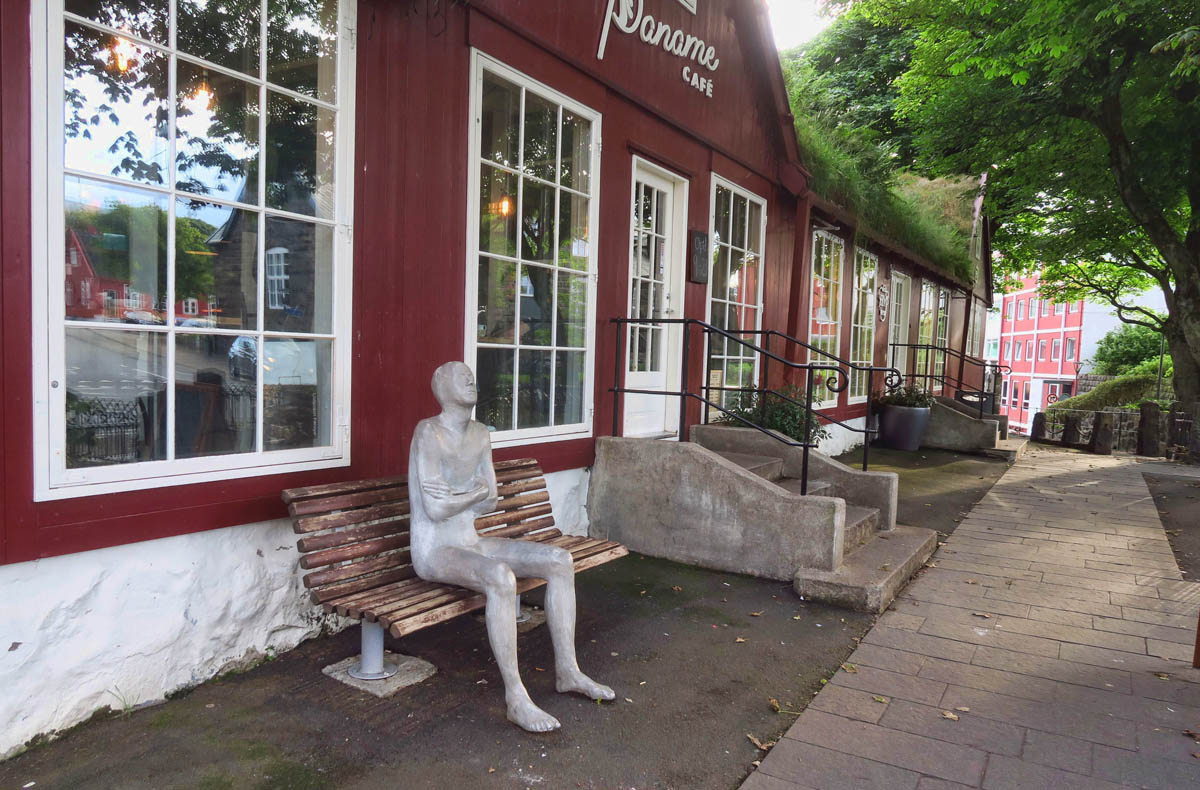
While Torshavn is one of the smallest capital cities in Europe with a population of only 14,000, it still offers some charming, unique cafes. This one has an adjacent bookstore.

Dining out in the Faroe Islands is not for the budget-conscious, but I found this ramen noodle shop that offered affordable meals. It was the best spicy miso soup I have ever tasted! (The pork on the side is imported, as there are no pigs on the Faroe Islands.)
I struggle to put into words how much I fell in love with this place. It was quirky, simple, stunningly beautiful, rugged, wild, and a little bit edgy. It’s tough to peg. Traveling to the small hamlets felt so isolating and remote, yet I was never much more than a couple of hours from anything I needed in the capitol city. It felt like a step back in time, yet I was never without a cell signal, and no-contact credit card was widely used. Roads were narrow one-lane paths, yet the Faroe Islands has one of the most advanced tunnel systems in Europe. I am reminded of the old joke about the Fugawi tribe, who when lost in the tall grass would ask “Where the Fugawi??” I asked myself that question every single day in the Faroe Islands. It just didn’t seem real.
The Faroe Islands are an archipelago of 18 islands in the North Atlantic Ocean about halfway between Norway and Scotland. The 540 sq miles of the island group is situated about 460 km (285 mi) east-southeast of Iceland, a short flight or in my case, a 20 hour overnight ferry ride. While the islands are self-governing as an autonomous territory, the island group belongs to the Kingdom of Denmark. However they maintain their autonomy which allows them to operate and maintain treaties and trade agreements outside of the European Union.
Once I discovered there was a ferry from Iceland, I was compelled to keep going on toward Denmark. However, the Smyril Line Ferry makes a stop in Torshavn, the capital city of the Faroe Islands. The ferry schedule is such that it is possible to disembark and spend a week touring the islands, then re-board the same ship the following week, continuing on to Denmark.

While the capital city of Torshavn contains many modern conveniences, once you get away from the capital, the villages are much smaller and more remote.
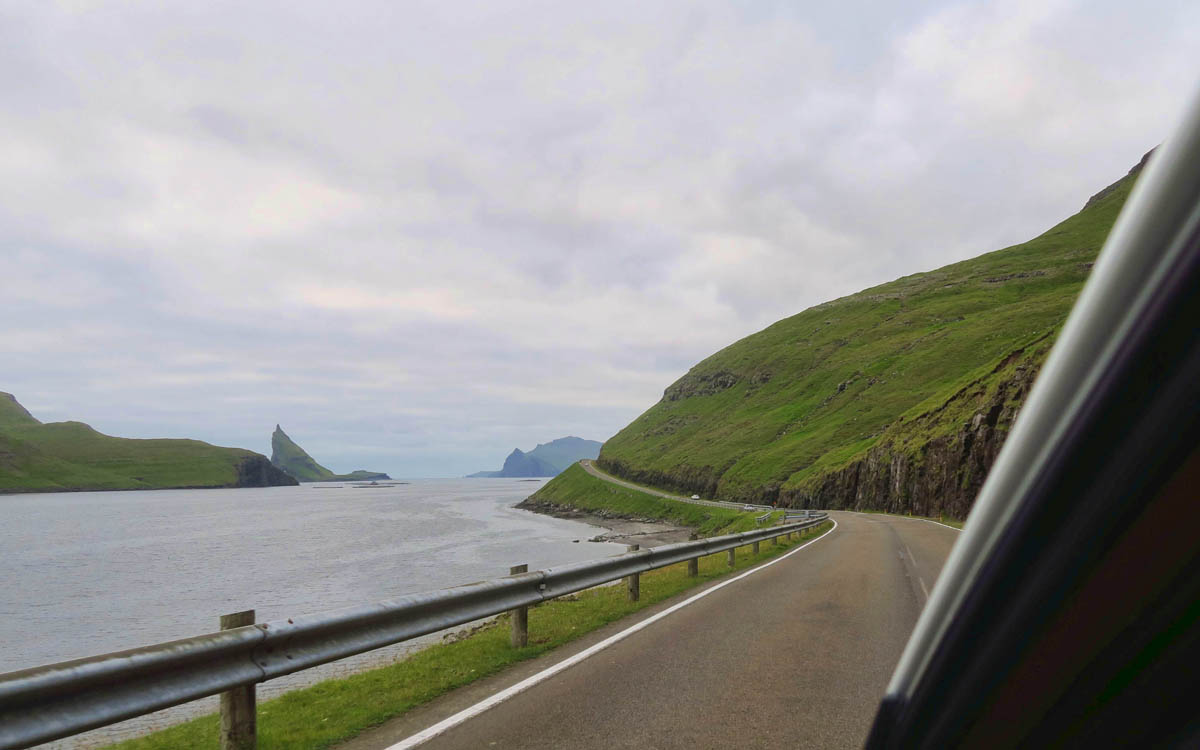
Distances between the villages is not as great as it seems given the narrow, winding roads that hug the curvy coastline, often shrouded in mist and fog.

They are almost exclusively residential with their token church in the center of town. This one, built in 1865, is in the village of Bøur, which in 2012 had a population of 75.
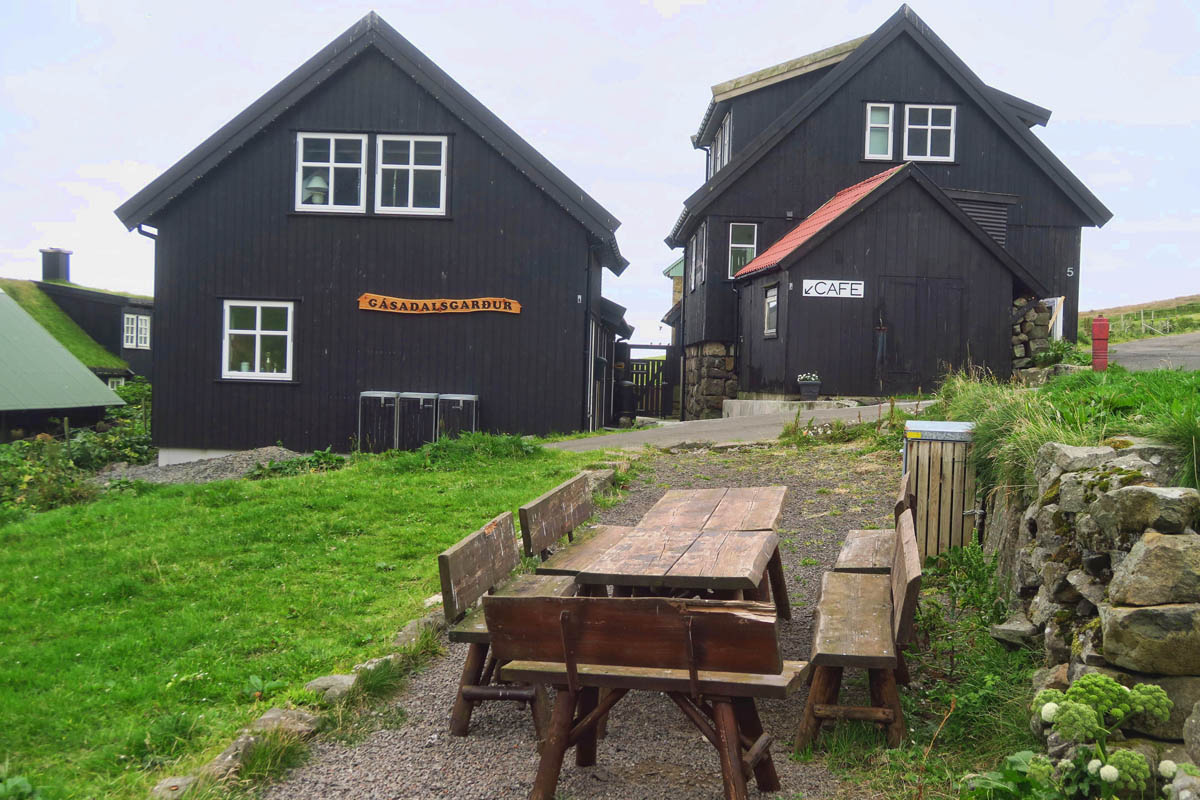
It was rare to see people anywhere, even in the villages.
I have much I want to share about this remarkable place, but first, I feel the need to address the ugly elephant in the room. I had moved on to the mainland, still basking in the afterglow of my week on what felt like “Fantasy Island,” when news began to spread about the Faroese latest event of “grindadráp,” their controversial whale hunting tradition. During this hunt, a pod of pilot whales will be surrounded by a group of privately owned boats.
Once the pod is corralled into the cove in shallow waters, they are killed using a spinal lance to sever the spinal column. The meat and blubber are then distributed among the community. On average, 800 pilot whales are killed annually out of an estimated population of 128,000 pilot whales in the area, a rate for non-endangered species that is considered “sustainable” by Faroese government standards.
I knew about this highly controversial local custom of the Faroese before I made the decision to visit, however it was on a much smaller scale. I stumbled across it while doing research, finding posts made by the group, the Sea Shepherd Conservation Society out of Seattle, an organization similar to Green Peace in their attempts to stop this ancient Faroese tradition. But seeing as how it is a cultural event that has been documented as far back as 1534, and considered to be a vital food source for the islands, I figured who am I to judge?
I figure as long as I am still carving my steak off the T-bone, or gnawing the meat off a roast turkey leg, I have no right to judge how another country gets its food source. They also eat sea birds, including puffins. This is equally offensive to me. I wince at the thought of hunting practices, yet how are they any worse than that slab of salmon that comes on a Styrofoam tray? Does wrapping it in plain brown butcher paper make it okay?
But then on September 21st, reports of the latest “grind” spread across the international news that a “super-pod” had been killed. Not only was it one of the largest hunts in recent history, it wasn’t pilot whales this time, but rather white-sided dolphins. Despite the article stating “The drives are regulated by laws and the meat and blubber are shared on a community basis,” it was impossible to get past the images of that many dolphins lying side by side, slaughtered on the beach of a cove turned red from the spilled blood. I had three different friends send me the link to the article asking “Did you hear about this?” I felt sickened by the news. But I also felt as if I needed to defend my decision for visiting a place with such a barbaric custom.

This iconic view of Múlafossur waterfalls with the hidden village of Gásadalur in the background has become one of the most photographed spots in the Faroe Islands.

The tiny village of Gásadalur was accessible by foot only up until 2006 when a tunnel was built through the mountain. Before that time, the mail was delivered on foot, three times per week. The old trail known as “The Old Postal Route” now serves as one of the more rigorous hiking trails.

For scale, note the size of the tiny black dot in the upper left of the photo. This is the tunnel reached by the switchback road, the only vehicular access to the village of Gásadalur.

There was a rare small area of semi-flat land around the village of Gásadalur, location of one of the few gardens I saw. Most were either turnips, potatoes or rutabagas.

This is the closest thing you will find to a supermarket in the village of Gásadalur. The little roadside stand is selling jars of canned turnips on the honor system. I loved the container of hand sanitizer on the side.
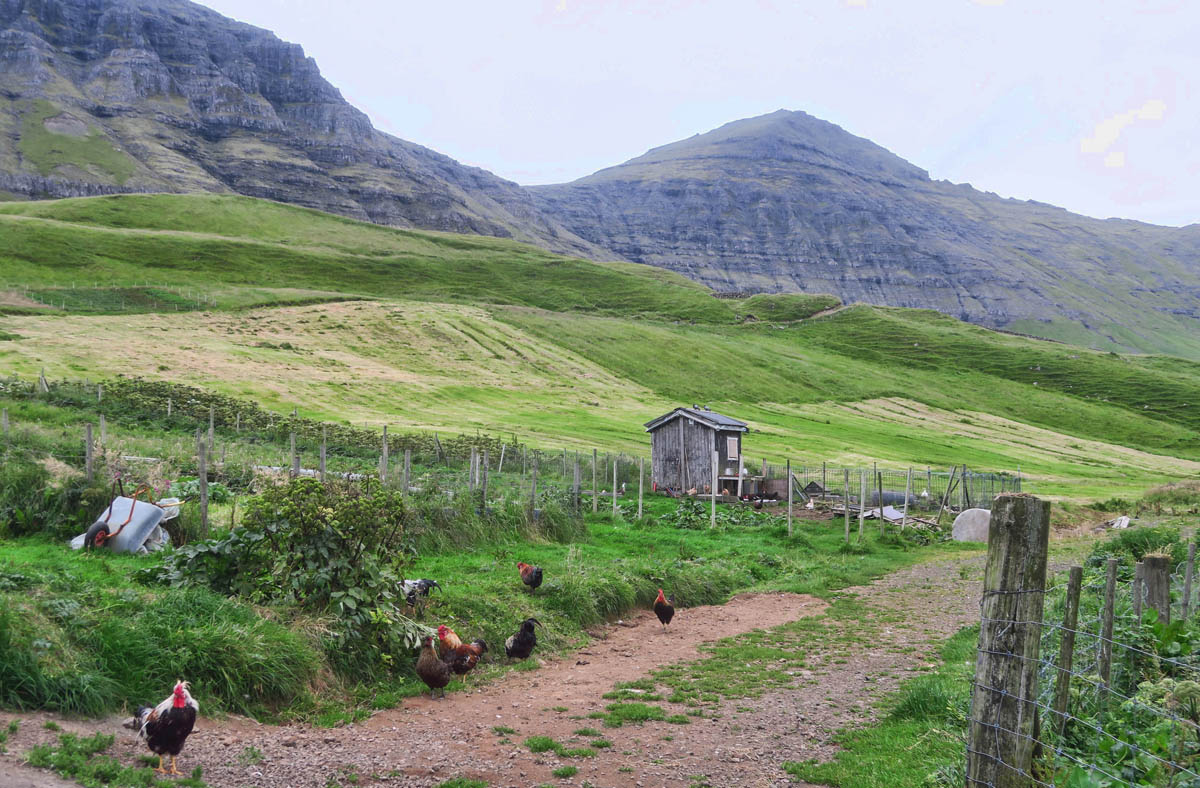
The villages are quite remote and rural. Not all of the households are inhabited year round. This is one of the rare households I saw raising chickens.

The Faroe Islands have more sheep than people. The local name Føroyar is sometimes translated as the “Islands of Sheep.” Until the 19th-century sheep breeding was the most important source of income and Faroese wool was the most important export.

The Faroese sheep are some of the most attractive sheep I have ever seen. It’s rare to see a plain white one, as most are spotted shades of white, caramel, brown and black. Did you know a sheep’s retina is rectangular shaped?
But I had a different perspective after having spent a week in the Faroe Islands. Were it not for the jar of peanut butter and crackers in my carry-on, I would have gone to bed hungry on more than one occasion. Once you leave the capital city of Torshavn with its supermarkets filled with imported goods, there just aren’t many markets and even fewer restaurants. In the more remote villages, you can’t even find gas station food. Not so much as a coffee shop. I’ll never forget encountering the Bonus Supermarket after a couple of days with no access to provisions. I had to laugh at myself as I ravaged the aisles like it was the first supermarket I had seen in weeks.
Due to the rugged nature of the Faroe Islands, only 2% of their land is viable for cultivation. I saw a few turnips and rutabagas being grown in gardens, but that was it. They grow “farm raised” Faroe Islands salmon in offshore pens, but that is shrouded by its own controversy, as being reported as inhumane treatment of the salmon. That leaves their sheep, but I am not sure how sustainable even that food source would be over the long winters. And how is slaughter of a sheep preferred over a dolphin?
Some of the villages have less than 100 inhabitants. Their only income source is tourism, or exports of wool and salmon. Being able to afford imported Danish ham on a sheep herder’s income is not likely. And how does a sheep farmer benefit from tourism? They recently began charging a fee to hike on their land, another practice that has met with much criticism. It’s very near the case of “hunt for you own food, or starve.” Therefore, one quarter of their food source comes from dried or salt-cured whale meat and blubber.
“Nature” takes on a new meaning in a place like the Faroe Islands. There are no zoos there. No wildlife preserves, nor are there any national parks or protected lands. What is typically considered a wildlife refuge in other countries is what the Faroese call home. They live amidst nature, therefore their culture dictates they depend on it for sustenance. With so few acres available to farm and such inhospitable climate, the sea becomes the obvious choice for harvest. You eat what you’ve got.

Most all of the land on the Faroe Islands is private property. In order to take advantage of tourism, many landowners have begun to charge a fee for hiking on their land. This has met with much criticism among the hiking community, however I really did not mind considering landowners put improvements in place to preserve the land such as these steps up what would otherwise be a slippery slope.

Trælanípa, one of the most popular hikes has this small hut to collect the hiking fee. There are also clean restrooms and a small coffee shop selling beverages and fresh baked croissants. Without these public restrooms on private lands, well….you know what happens.
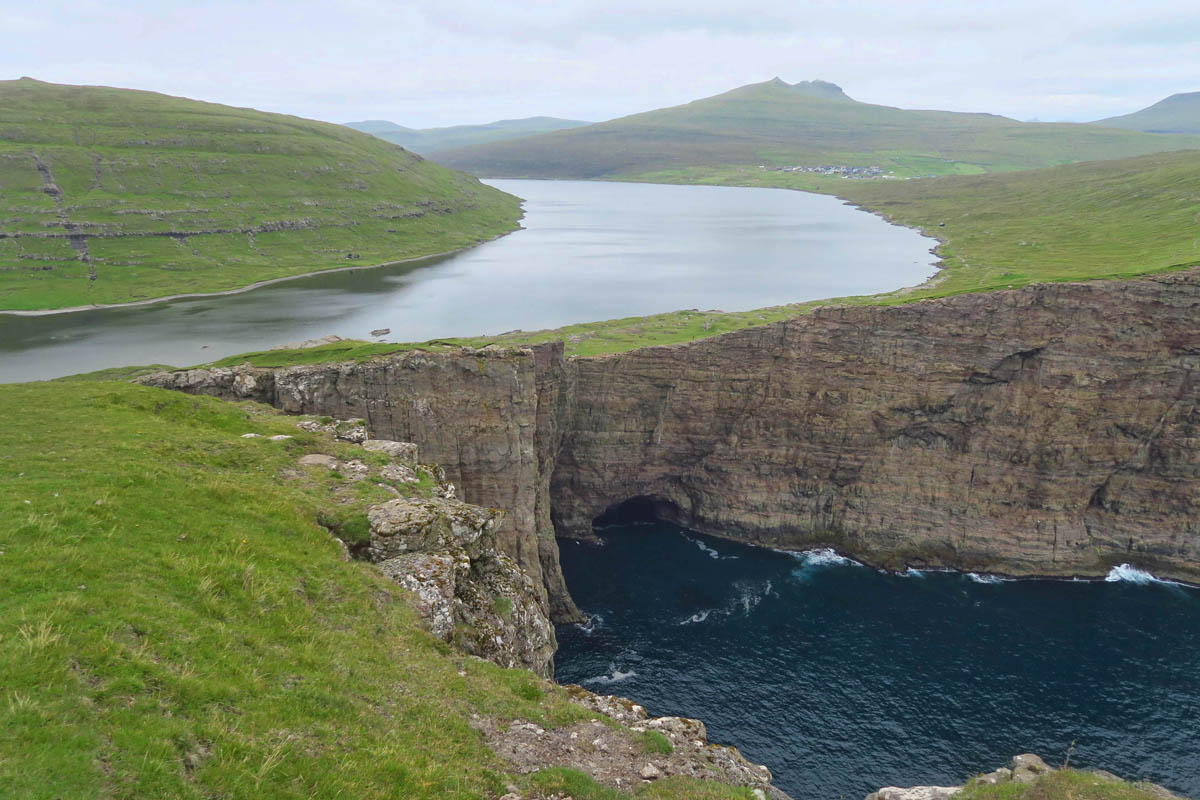
Only the most popular hiking destinations impose a fee. This hike is known as “the lake over the ocean,” and is a popular spot with photographers.

The vantage point from the top gives the illusion of a “hanging lake.”

Note about one third up the coastline is Bøsdalafossur waterfall, where the lake pours over into the ocean.

Is it reassuring or terrifying seeing a boat marked “RESCUE” beneath a cliff like this?
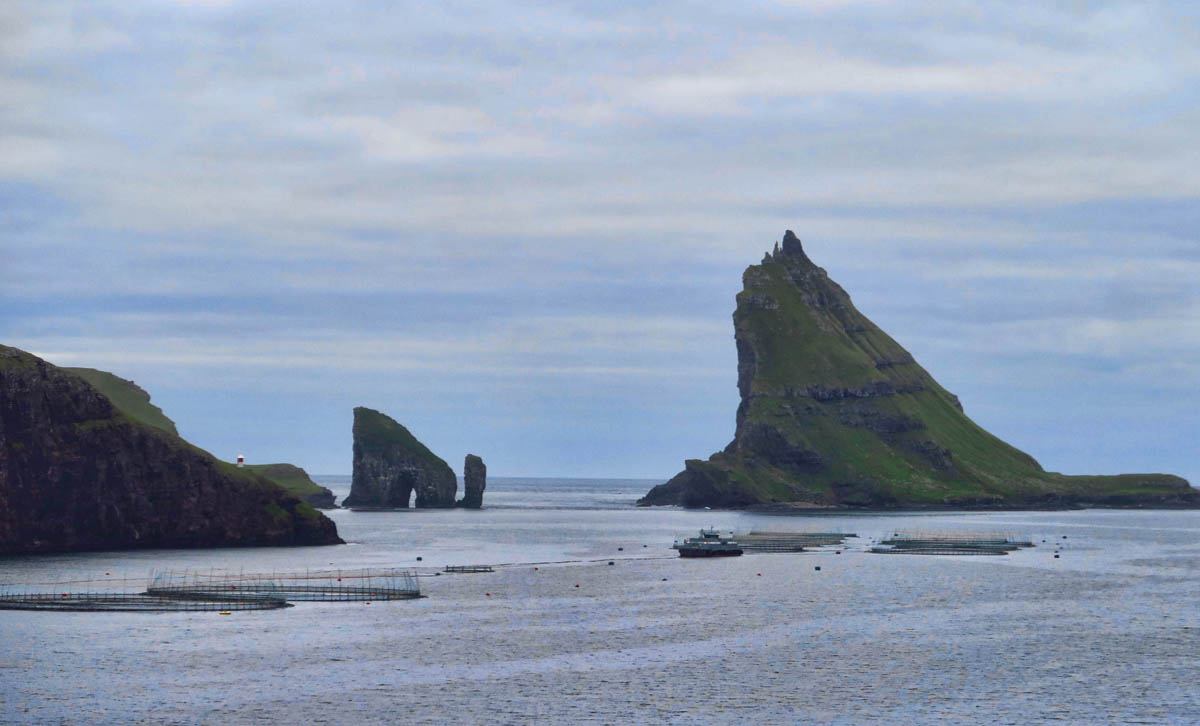
This view overlooks the neighboring “drangar”, (tall, pointed clifftops sticking up from the sea) as well as the rocky islet Tindhólmur with its many peaks. In the foreground is one of the many Faroese salmon farms found in the North Atlantic waters surrounding the islands.
To be clear, I do believe mass slaughter of sea mammals is wrong. I don’t even eat octopus, for goodness sake, because they are one of the most intelligent creatures in the sea. But I also believe that as long as the practice of “the grind” is legal in the Faroe Islands, and the mammals are not endangered, it’s their business. To otherwise force outside beliefs on these small, remote islands could qualify as the recently coined term “cultural imperialism.”
There are two schools of thought on travel to controversial tourist destinations such as the Faroe Islands. There are calls to boycott travel due to this ancient cultural tradition of grindadráp. On the other hand, some say visiting there calls to light that change is needed in these centuries-old, outdated hunting practices. I am just not sure what the solution would be when living on such a remote group of mountainous, inhospitable islands surrounded by the sea. It’s tough to pick a side, particularly for a “cow man’s daughter” like me…

Just a 20 minute ferry ride away from Torshavn, the capital city, is the tiny island of Nólsoy. If you are a senior, it only costs about $4 to get there and back.

There is nothing comforting about this sign at the entrance of the Nolsoy ferry.

This small island of Nólsoy has only one settlement by the same name. I was advised not to take my rental car on the ferry, as there is no where to drive once you get over there. 😉

While the little village is certainly worthy of a visit, I am here to hike to the Nólsoy Lighthouse, a 14 km (8.5mi) up over the steep hill and through a marshy bog.

This is how you climb the fence in the Faroes. Just step up on the creaky old 2×4 and hope for the best.

While there are lots of cairns marking the path, hiking in the Faroes also comes with a lot of warnings. Fog can set in quickly and completely disorient the hiker. Brochures advise if that happens, it’s best to wait by the nearest cairn until the fog lifts, lest you walk off the edge of a cliff.

I had lunch on the porch of the former lighthouse keeper while waiting for the fog to lift. Back in 1893 When this beautiful royal old girl was built, the lens was one of the largest in the world. It’s 2.82 meters (almost 10 ft!) high and weighs four tons. Fortunately, the fog did clear long enough for me to get a glimpse of the coastal edge far below. (Another selling point for Gaia hiking app, as I was able to load the trail in my app and track my hike for “worst case scenario.”
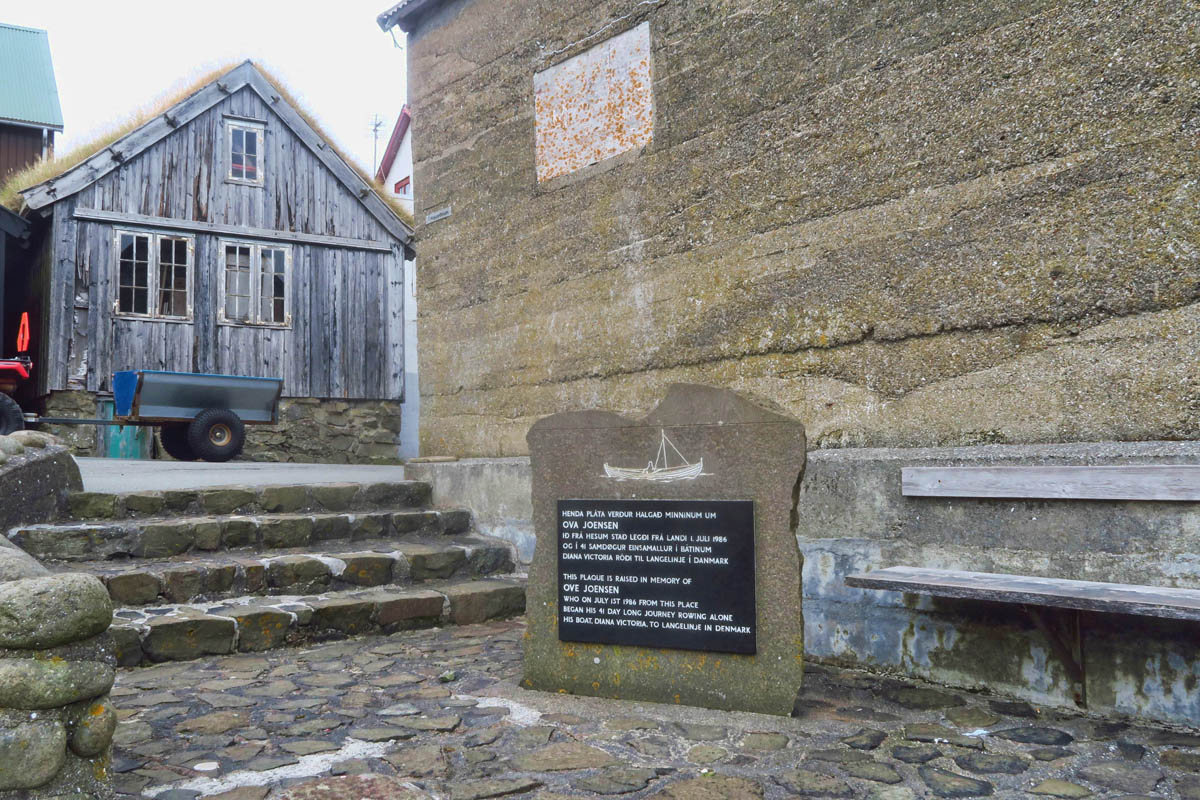
This spot in the settlement of Nolsoy marks the spot where Ove Joensen began his 41 day journey rowing his boat alone across the North Atlantic to Denmark. He has become a bit of a folk hero as a result.
With that bit of culture and controversy out of the way, I look forward to posting more about the beautiful flora and fauna of these remote islands. Next stop, Mykines, the westernmost of the Faroe Islands.

Oh wow! It’s all totally amazing!
Thank you, Terri. It was an amazing place indeed! Hard to describe, really…
In general “our view” of right and wrong concerning the use of this glorious planet we live on has become so attuned to “our particular lifestyle” its easy to misjudge “other views” so easily. Its good to see the world through eyes like yours that can hold personal convictions that do do preclude those of others, particularly those we are not completely informed about. Personally I dont eat octopus that often ( because its just not prepared well) but i do eat plenty of pork, even though pigs intelligence levels are very high as well! 🙂
Keep Sharing the wonderful adventures! Please!
Thanks, Jim. I never knew that about the pig’s intelligence level. That prompted me to google the intelligence rank of animals. Thankfully I have only consumed two out of the ten. Creepy that rats made the Top 10 list! Very interesting!
The Faroes are on my list very near the top. I am thrilled to see you made it there. BTW, the “Like” button is gone on this post, so I will just say, I liked it!!! A lot!
Thank you, Ed. The blog seems to have a mind of its own these days. Things disappear unknowingly, but I just keep hoping the posts and photos show up! I thought about you and Marti a lot during my Faroe Islands visit, because it reminded me so much of Newfoundland. Thanks for “liking.”
Wow! I really enjoy all the information you capture on this trip. And beautiful photos.
Thanks, Tina. I appreciate you following along, and for the nice compliment.
Tom Russell sings about Ove Joensen on his great record “Folk Hotel”.
Thanks, Creigh. I didn’t know about this. I searched on youtube and found an interesting interview. I can’t find the specific song on the album, tho. Do you recall which one?
I suspect that the cumulative negative impact on the planet of a Faroese citizen is much less that that of those individuals protesting their cultural practices.
Thanks, Greg. It is interesting to contemplate when you put it in perspective, isn’t it? I read one article that argued, why should the sea life be preserved from injesting so it can become toxic as a food source from mercury, possibly from pollution. Interesting to ponder…
Thank you so much, Suzanne, for sharing this amazing journey with such thoughtful words and gorgeous photos. I followed you all through Iceland, overwhelmed by the immensity of the place, the wonder of it all…such that I felt completely unable to utter a decent comment. Here, I must finally once again say thank you. Cows, whales, as you say, is there really a difference? I eat cows and chickens, and yet when I see the images of the I think Swedish guy and his cows I suffer a bit, but not enough to stop. I love chickens, and I still eat them. It is a conundrum I guess. People on these islands have no option to eat a plant-based diet. I do, but I still don’t. It is really difficult to recognize my own hypocrisy. I drive a gas-powered car, a motorhome, and I really would hate to give up my natural gas stove and furnace in my home for all electric that to me never feels really warm. So how dare I complain about pipelines and global warming? I recycle, I do all sorts of stuff, but I am not willing to give up meat or fuel so where does that leave my hypocritical complaints? My footprint on the planet will soon be reduced to zero when I leave, and the younger generation will reap the rewards of my unwillingness. No clue how to resolve it. And I am glad you went to the Faroe Islands and shared your visit so beautifully.
Sue Malone, this comment brought tears to my eyes. You said this so well that it made me wish I had asked you to write a guest post, as you said it so much more succinctly that I could. “I do, but still I don’t” sums it all up. It is indeed a conundrum. Thank you for the wonderful, thought-provoking comment.
Sue Malone said it splendidly. I’m right there with you, Sue. I know the practices of killing cows and chickens over here can’t be pretty, but since I’m not willing to go totally vegan, I look away. I cannot and will not fault how others get their food sources in other countries.
On another note – I love that Nordic architecture! Looking forward to your next post – I just know you’ll throw in a bird or 2 for me and your mom 😉
Thanks, my dear Cuz. More bird pics coming right up. You’re not tired of puffins yet, are you? They are the only birds I can identify. 😉
It certainly is a controversy with the traditional fishing styles. The people need to eat and using what is around them makes sense. Maybe a few lessons in more humane treatment during the gathering!? I’m of the school that buying any meat/fish in the grocery makes it not from a live creature!! Haha! What an amazing experience, though, to visit and see first hand these remote islands. Love the lake over the ocean! And that close up of the sheep is beautiful. All the colors of the buildings makes one smile and everything come alive. Thanks for sharing!
Thanks for the comment, Pam. Interestingly enough, this “spinal lance” is supposedly a more humane way, as it supposedly kills them rapidly. But I am sure the “rounding up” process cannot be humane. One of our mutual friends (who shall remain nameless since it was in a private email) said it best, that they are “at least free-roaming until their sad demise.”
Wow!
Thanks for sticking with me, my friend.
Oh, my goodness! This post held so much interest I had to read it twice! Since I am late to the comment section any thoughts I might make note of have already been covered above. With culture and controversary understood (thank you for bringing to light) I am mesmerized by the beauty of this land and sea!
Every photograph merits a note of appreciation but I especially enjoyed three: the sheer face cliff with the rescue boat below (I thought about the Fool in a deck of Tarot), the beautiful village of Nolsoy with colorful roofs and building facades and that scrumptious lighthouse, which looks like a structure built of mini marshmallows with a cherry perched on top!
What a magnificent stop in your travels, Suzanne!